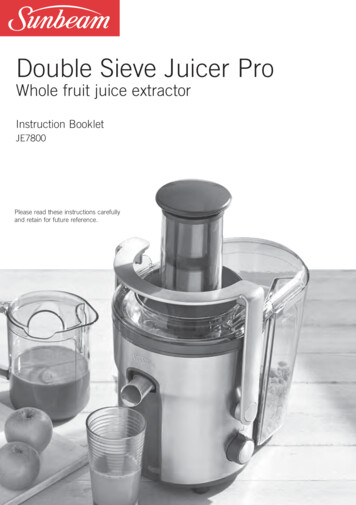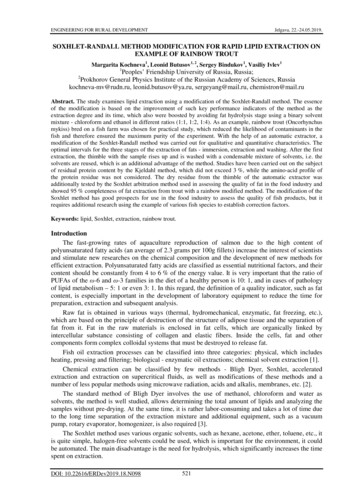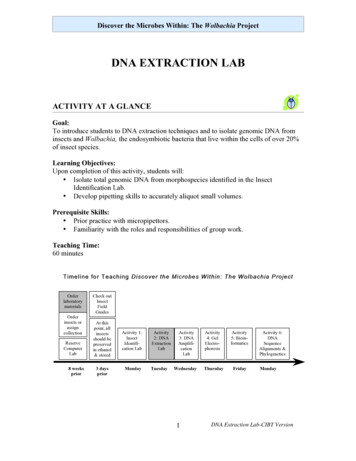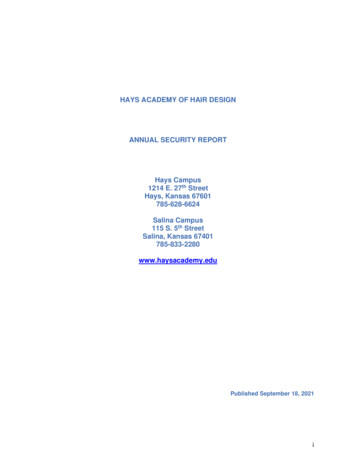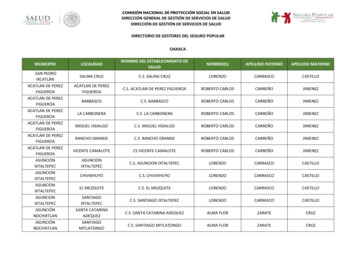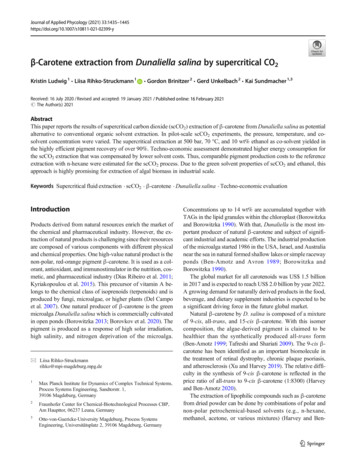
Transcription
Journal of Applied Phycology (2021) 2399-yβ-Carotene extraction from Dunaliella salina by supercritical CO2Kristin Ludwig 1 & Liisa Rihko-Struckmann 1&Gordon Brinitzer 2 & Gerd Unkelbach 2 & Kai Sundmacher 1,3Received: 16 July 2020 / Revised and accepted: 19 January 2021 / Published online: 16 February 2021# The Author(s) 2021AbstractThis paper reports the results of supercritical carbon dioxide (scCO2) extraction of β-carotene from Dunaliella salina as potentialalternative to conventional organic solvent extraction. In pilot-scale scCO2 experiments, the pressure, temperature, and cosolvent concentration were varied. The supercritical extraction at 500 bar, 70 C, and 10 wt% ethanol as co-solvent yielded inthe highly efficient pigment recovery of over 90%. Techno-economic assessment demonstrated higher energy consumption forthe scCO2 extraction that was compensated by lower solvent costs. Thus, comparable pigment production costs to the referenceextraction with n-hexane were estimated for the scCO2 process. Due to the green solvent properties of scCO2 and ethanol, thisapproach is highly promising for extraction of algal biomass in industrial scale.Keywords Supercritical fluid extraction . scCO2 . β-carotene . Dunaliella salina . Techno-economic evaluationIntroductionProducts derived from natural resources enrich the market ofthe chemical and pharmaceutical industry. However, the extraction of natural products is challenging since their resourcesare composed of various components with different physicaland chemical properties. One high-value natural product is thenon-polar, red-orange pigment β-carotene. It is used as a colorant, antioxidant, and immunostimulator in the nutrition, cosmetic, and pharmaceutical industry (Dias Ribeiro et al. 2011;Kyriakopoulou et al. 2015). This precursor of vitamin A belongs to the chemical class of isoprenoids (terpenoids) and isproduced by fungi, microalgae, or higher plants (Del Campoet al. 2007). One natural producer of β-carotene is the greenmicroalga Dunaliella salina which is commercially cultivatedin open ponds (Borowitzka 2013; Borovkov et al. 2020). Thepigment is produced as a response of high solar irradiation,high salinity, and nitrogen deprivation of the microalga.* Liisa Rihko-Struckmannrihko@mpi-magdeburg.mpg.de1Max Planck Institute for Dynamics of Complex Technical Systems,Process Systems Engineering, Sandtorstr. 1,39106 Magdeburg, Germany2Fraunhofer Center for Chemical-Biotechnological Processes CBP,Am Haupttor, 06237 Leuna, Germany3Otto-von-Guericke-University Magdeburg, Process SystemsEngineering, Universitätsplatz 2, 39106 Magdeburg, GermanyConcentrations up to 14 wt% are accumulated together withTAGs in the lipid granules within the chloroplast (Borowitzkaand Borowitzka 1990). With that, Dunaliella is the most important producer of natural β-carotene and subject of significant industrial and academic efforts. The industrial productionof the microalga started 1986 in the USA, Israel, and Australianear the sea in natural formed shallow lakes or simple racewayponds (Ben-Amotz and Avron 1989; Borowitzka andBorowitzka 1990).The global market for all carotenoids was US 1.5 billionin 2017 and is expected to reach US 2.0 billion by year 2022.A growing demand for naturally derived products in the food,beverage, and dietary supplement industries is expected to bea significant driving force in the future global market.Natural β-carotene by D. salina is composed of a mixtureof 9-cis, all-trans, and 15-cis β-carotene. With this isomercomposition, the algae-derived pigment is claimed to behealthier than the synthetically produced all-trans form(Ben-Amotz 1999; Tafreshi and Shariati 2009). The 9-cis βcarotene has been identified as an important biomolecule inthe treatment of retinal dystrophy, chronic plaque psoriasis,and atherosclerosis (Xu and Harvey 2019). The relative difficulty in the synthesis of 9-cis β-carotene is reflected in theprice ratio of all-trans to 9-cis β-carotene (1:8300) (Harveyand Ben-Amotz 2020).The extraction of lipophilic compounds such as β-carotenefrom dried powder can be done by combinations of polar andnon-polar petrochemical-based solvents (e.g., n-hexane,methanol, acetone, or various mixtures) (Harvey and Ben-
1436Amotz 2020). The extraction of β-carotene and other carotenoids requires mild conditions regarding temperature, lightexposure, and time to minimize auto-oxidation and isomerization (Arvayo-Enriquez et al. 2013; Herrero et al. 2006).Nowadays, n-hexane is one of the most commonly used solvents to extract non-polar carotenoids from natural materials(Yara-Varon et al. 2016). However, the risk of product contamination or loss of quality due to organic solvent residuals inthe extracts provokes a rising need of innovative extractionmethods. One potential approach in this direction is the supercritical fluid extraction which makes use of the unique solventproperties of supercritical fluids or gases which are heated andpressurized above their critical points Pc and Tc. The densityof the supercritical fluid is comparable to liquids, whereas theviscosity is similar to that of gases. The supercritical physicalproperty enhances the heat and mass transfer of the solute tothe extract. Consequently, the diffusivity of the solvent ishigher than that of conventional liquids resulting in an improved solvent power (Meullemiestre et al. 2015).Furthermore, the selectivity of a supercritical fluid can be influenced by altering the pressure and the temperature withinthe supercritical window, allowing a more precise extractionof specific products (Brunner 2005; Kitada et al. 2009;Macias-Sanchez et al. 2009a, 2009b; Ruen-ngam et al.2012). The methodology has the advantage of a completesolvent recovery from the extracts without the need ofdistillation.So far, a few studies have reported the supercritical fluidextraction of valuable lipophilic compounds, carotenoids(Obeid et al. 2018; Leone et al. 2019), or especially the βcarotene from algal biomass (Molino et al. 2019). However,most of the studies are carried out in the lab scale (Jaime et al.2007; Macias-Sanchez et al. 2008; Macias-Sanchez et al.2009a; Hosseini et al. 2017; Molino et al. 2019). On the industrial scale, the method is applied for astaxanthin recoveryfrom Haematococcus pluvialis by Cyanotech in Hawaii.Recently, the environmental and economic perspectives ofthe extraction for β-carotene extraction from D. salina wereassessed in a simulation study (Espada et al. 2020). The cosolvents have been reported as beneficial for extraction ofcarotenoids from various microalgae (Machmudah et al.2006; Nobre et al. 2006). The addition of an entrainer canprovide a significant boost; however, the function principlesof the entrainers are still under debate (Shimizu and Abbott2016). Ethanol was identified as the best co-solvent for extraction of β-carotene D. salina by the prediction based on theHansen theory (Tirado and Calvo 2019). Ethanol as cosolvent was investigated experimentally in supercritical fluidextraction also by Molino et al. (2018) for astaxanthin andlutein extraction from H. pluvialis.In the present study the potential of supercritical fluids asan alternative to conventional solvent extraction of D. salinabiomass is evaluated. The first envisaged target of the studyJ Appl Phycol (2021) 33:1435–1445was the optimization of the extraction procedure by comparing seven solvents or solvent mixtures for the Dunaliella biomass. Secondly, the potential of supercritical fluid extractionwas assessed by means of experimental investigation in a pilotscale. Finally, the energy consumption and the economics ofthe technique for the β-carotene recovery were compared tothose of the state-of-art extraction with n-hexane.Materials and methodsBiomassSpray-dried Dunaliella salina powder (supplied by DenkIngredients GmbH, Germany, Art. no: 967996) was used inall extraction experiments. The β-carotene content of the biomass varied slightly between the charges; however, maximally a content of 47.8 mg g 1 was determined in the charges bythe analytical method of Lichtenthaler (1987). The biomasscharges used in our study contained entirely all-trans isomerand negligible amount of 9-cis isomer as confirmed by HPLCmeasurement. The total neutral lipid amount of the biomasspowder was 11.5 wt% (Pirwitz et al. 2016). According to BenAmotz and Avron (1989), spray drying, freeze-drying, anddrum drying are appropriate for Dunaliella biomass, resultingin a minor variation of the quality of the biomass powder andhigh stability of the pigment. Therefore, we might assume anegligible effect of the used drying method on the exactionresults.Selection of appropriate organic solventsFor comparison, conventional solvent extraction experimentswere conducted using THF (tetra hydro furan), acetone, nhexane, ethanol (96 Vol% and 99 Vol%), ethyl acetate, andchloroform/methanol (2:2.5). The solvents were selectedbased on their experimental determined solubilities of βcarotene according to Craft and Soares (1992). Sincechloroform/methanol mixture is frequently used in literatureto extract the pigments (e.g., Lamers et al. 2010; Mezzomoand Ferreira 2016), a chloroform/methanol ratio of 2:2.5 wasapplied for β-carotene extraction instead of using the solventsseparately. Ethanol was applied as 99 Vol% and 96 Vol%concentration in water since the presence of low amounts ofwater in ethanol is expectedly beneficial for the extraction.Determination of β-carotene concentrations in theextractsStandard calibration curves of β-carotene absorption wereprepared in the above-mentioned solvents to determine thepigment concentration in the extracts according to the protocolof Craft and Soares (1992). In short, a stock solution
J Appl Phycol (2021) 33:1435–1445containing 3 mg mL 1 of a β-carotene standard (SigmaAldrich, Germany) was prepared in THF supplemented with0.1% (v/v) of the antioxidant butylated hydroxytoluene. Thestock was diluted 1000-fold with the respective organic solvent (referred to as stock solution 2). In the next step, thewavelength λmax of the absorbance maximum was determinedfor each solvent stock solution 2 by analyzing the completespectrum of β-carotene from 200 to 700 nm (see Table S1).Afterwards, the absorbance at λmax was measured spectrophotometrically in the respective solvent for various defined pigment concentrations. With the data, the observed linear regression between the absorbance and β-carotene concentrationwas used to calculate the β-carotene concentrations in theextraction samples.Extraction of β-carotene by organic solventsFirst, the influence of the extraction time and temperature aswell as water content (in ethanol) on the extraction was investigated experimentally. The experiments were conducted intriplicates of sealed 100 mL shaking asks filled with 25 mLof the respective solvent and 100 mg of D. salina. The solventto biomass ratio was defined according to the experimentaldetermined solubility values of β-carotene (Craft and Soares1992). The samples were extracted in the dark using a rotaryshaking incubator with a frequency of 100 rpm. Extraction for30, 60, 90, 120, and 180 min were applied at 20 C to examinethe influence of time on the extraction efficiency.Furthermore, the β-carotene extraction efficiency was analyzed at the temperatures of 20, 40, and 60 C during a constant time of 30 min.The efficiency of the extraction was quantified by absorbance. Therefore, duplicate suspension samples were takenfrom each shaking ask after extraction, transferred into nontransparent, brown tubes and centrifuged at 5000 rpm for5 min to separate the algal sample and solvent. The supernatant was analyzed spectrophotometrically at the previouslydetermined wavelengths λmax (Table S1). Pigment concentrations were quantified using the regression standards(Determination of β-carotene concentrations in the extractsSection ).1437mitigated the agglomeration of the biomass during the experiments. The extractor was sealed with sintered metal plates onboth ends. The plates were covered by cellulose filter paper(2.5 μM, Cat. no.: 1005320, Whatman, UK) to avoid biomassintrusion through the plates into downstream pipelines andvessels. CO2 (operated at 62 bar) was delivered from a feedtank that was supplied by an external CO2 source. The solventCO2 was pressurized up to the investigated extraction pressureby a compressor and tempered to the extraction temperatureby a heat exchanger. The co-solvent ethanol (96 Vol%) wasadded to the CO2 stream from a separate feed tank connectedclose to the extractor vessel inlet. The influence of the cosolvent ethanol was analyzed by varying the ethanol massfraction in the solvent stream at levels of 0, 4, and 10 wt%.The temperature and pressure of ethanol were adjusted similarto the CO2 stream by a heat exchanger and a compressor. Thetotal mass ow of the extracting solvents CO2 and ethanol wasmeasured by a flow meter, and it was approximately 4–5 kgh 1. The extraction time was 180 min in all supercritical CO2extraction experiments.During the experiments, the temperatures of 50, 60, and 70 C were applied for the extractor. The extraction pressures of300, 400, and 500 bar were investigated. After passing theextractor, the solvent-extract mixture was conducted into aseparation vessel operating at 50 C and 62 bar. Here, CO2evaporated and separated from the ethanol-extract mixture,and it was recycled back into the CO2 tank. For sampling ofthe liquid ethanol-extract, an outlet valve was openedallowing the complete draining of the separator vessel contentinto preweighed brown glass flasks. In experiments withoutco-solvent, the separator vessel was filled with 500 mL ethanol prior to an extraction experiment to facilitate the collectionof extracted β-carotene.Extract samples taken during the experiments were analyzed spectrophotometrically (spectrophotometer Type 7310,Jenway, UK) at the specific wavelength determined as described in Determination of β-carotene concentrations in theextracts Section. A standard curve of β-carotene in 96 Vol%ethanol was used to quantify the pigment concentration in thesamples.Extraction of β-carotene by scCO2Determination of scCO2 extraction efficiency and βcarotene solubilityThe extraction experiments with supercritical CO2 were carried out in pilot scale in the facilities of the Fraunhofer Centerfor Chemical-Biotechnological Processes (CBP, Leuna,Germany). Figure S2 schematically illustrates the design ofthe continuously operating extraction unit. For each experimental run, 100 g D. salina biomass was placed into a 2 Lextractor vessel and mixed with approximately 1300 g stainless steel cylindrical filling rings (5 5 0.3 mm, RaschigGmbH, Germany). The Raschig rings in the extractor vesselDue to the high extraction power of acetone (as reported inOrganic solvent extraction of β-carotene from D. salinaSection) for β-carotene, this solvent was used to comparethe extraction efficiency under varied scCO2 extraction conditions. For this, after every scCO2 extraction experiment, thebiomass samples were collected and stored until analysis innon-transparent, dark tubes at 20 C. The remnant amount ofβ-carotene in the scCO2-extracted biomass was determinedby a subsequent acetone extraction and compared to that of
1438J Appl Phycol (2021) 33:1435–1445the fresh biomass. All samples were treated equally in order toquantitatively compare the residue amount of β-carotene inthe extracted samples: The samples were dried in the dark at40 C for 1 h to remove residual traces of the co-solventethanol. Afterwards, the biomass samples were weighted intoaluminum foil-covered 15 mL tubes (n 3-4) in portions of0.5–1.2 mg. One milliliter acetone per 0.1 mg biomass wasadded into the tubes. Samples were mixed and incubated inthe dark at 500 rpm and 20 C for 1 h. Subsequently, the tubeswere centrifuged to separate the biomass from the solvent, andtriplicates of supernatant acetone were measured at 455 nm.The β-carotene concentration was calculated using a standardcurve (see Determination of β-carotene concentrations in theextracts Section). The extraction efficiency ηE was determinedbased on the following equation:ηE ¼ct0 ctENDct0ð1Þwhere ct0 and ctEND are the measured β-carotene concentrations in acetone using the fresh biomass or biomass after extraction in mg g 1dw . The same re-extraction with acetone wasapplied for n-hexane-extracted biomass to quantify the extraction efficiency of n-hexane. The solubility Se of β-carotene inscCO2 in mg g 1 CO2 was calculated according to the methodof Danielski et al. (2007) as the slope of the linear phase of theextraction curves (phase I in Figure S1) reached in the experiments described in Extraction of β-carotene by scCO2Section .schematically illustrated in Fig. 1. The energy demandfor the product extraction comprises the energy requiredfor solvent delivery as well as for compression, heating,and cooling.For the techno-economic calculation, one extraction condition (500 bar, 70 C, and a co-solvent addition of 10 wt%ethanol) was taken as reference as the best extraction yieldwas obtained under this condition in the pilot scale. The energy demand for the compression of CO2 and EtOH was estimated according to Eq. 2 (Attard et al. 2015). Therefore, thespecific enthalpies h i of 320.97 kJ kg 1CO2 and 854.79wereusedtoquantifytheenergydemand of comkJ kg 1EtOHpression EEi in kJ (NIST 2016):E Ei ¼ hi msiFor the cost estimations, an extraction was assumed to beoperated in a continuous mode using an isolated extractor witha working volume of 400 L and a biomass density of 0.5 kgdwL 1. The approach is similar to that applied for scCO2 extraction of ginger powder by Rosa and Meireles (2005). The estimated mass flows of the solvents were 2.12 kgCO2 L 1 h 1 and0.24 kgEtOH L 1 h 1, and one sample was extracted 3 h.Accordingly, the solvent masses, msi, during the operation(tE 3 h) was calculated to be 2550 kgCO2 and 288 kgEtOH.The heating up of the input flows to the extractor was estimated with an efficiency η of 80% (Delrue et al. 2013). Theenergy required for heating was calculated by Eq. 3:Qhi ¼Energy and operating cost estimation of scCO2extractionTo quantify the energy demand and the operating costs ofthe scCO 2 extraction, the process model described inPirwitz et al. (2015) was modified by replacing the unitof n-hexane extraction with that of scCO2 extraction asð2Þcpi ΔT miηExð3Þwhere Qhi is the required heat energy, cpi is the heat capacity ofthe component i, ΔT is the temperature change, and mi is themass of species i.For the algal biomass, cpi 1.25 kJ kg 1 K 1 was assumed(Orosz and Forney 2008). The cpi of EtOH and CO2 are 2.50and 0.83 kJ kg 1 K 1, respectively.Fig. 1 Process scheme of industrial β-carotene production by D. salina. The process is divided in sections as follows: cultivation for biomass generation,dewatering (centrifugation), and drying step as well as the product extraction unit where either scCO2 or n-hexane is applied as solvent
J Appl Phycol (2021) 33:1435–14451439After extraction, the mixture consisting of CO2, EtOH, andβ-carotene was separated in a separation vessel at 62 bar and50 C. Therefore, the stream was cooled from 70 to 50 C, andthe energy for that was assumed to be provided by a coolingunit operated with cooling water. The required cooling energyQci was estimated by Eq. 4 (Attard et al. 2015) using thecoefficient of performance, COP 1.875. At the given temperature, the heat capacities of EtOH and CO2 are 3.10 and0.87 kJ kg 1 K 1, respectively.QCi ¼ cpi Δ T mi COPð4ÞThe evaporation process was simulated with an efficiencyηv of 70% to compensate heat transfer limitation and boilingpoint elevation due to impurities in the EtOH extract solution.The heat of evaporation Qv, ETOH for the co-solvent EtOH wascalculated using an evaporation enthalpy hv, ETOH of 841 kJkg 1 (boiling point Tb 78.37 C) (NIST 2016):Qv;ETOH ¼hv;EtOH mEtOHηvð5ÞRegarding solvent losses during recycling, a recovery efficiency of 99% was used in the calculations. The energy consumption of the n-hexane extraction was estimated based onthe parameters and assumptions given in Pirwitz et al. (2015).In the cost estimation, we assumed the extraction efficiency ofηE 86.4%. This efficiency value for n-hexane was obtainedexperimentally in our study by the re-extraction of the nhexane-extracted biomass with acetone (for details, seeExtraction of β-carotene by organic solvents Section). Asemi-quantitative techno-economic comparison of scCO2and n-hexane extraction was carried out (Energy and costassessment of the extraction strategies Section). The initialcosts of CO2, EtOH, and n-hexane were included in the dailyoperation costs assuming 330 production days of the year. Thenumeric values of the energy consumption for the unit operations are given Table S2, and the model was implemented inMATLAB (MathWorks). Uncertainties of the data were obtained by Monte-Carlo simulations as described in Pirwitzet al. (2015).ResultsOrganic solvent extraction of β-carotene fromD. salinaThe present study aims to investigate the influence of differentprocess parameters on the extraction results of β-carotenefrom D. salina biomass. Initially, we aim to identify the optimal organic solvent extraction conditions, which were used asreference to reliably compare the costs of conventional andsupercritical fluid extraction.The stability of pigments is dependent on the temperature,light, and the selected solvent (Tang and Chen 2000).Therefore, we initially looked for the optimal extraction timeand temperature for β-carotene extraction in the lab-scalebatches. Figure 2a illustrates the effect of time on the yieldof extracted β-carotene reached at 20 C. As seen in Fig. 2a,the best solvents under these conditions are acetone, THF,ethyl acetate, or the chloroform/MeOH mixture. Ethanol andn-hexane demonstrate lower β-carotene extraction yields being roughly half of those with the other solvents. Apart fromthe time, also the temperature affects the extraction yield byinfluencing the solute-solvent interaction. Based on the resultsshown in Fig. 2a, a time of 30 min was used in the study of thetemperature effect. Figure 2b demonstrates the strong influence of the extraction temperature on the β-carotene yield inthe batch experiments using the organic solvents.The results above demonstrated the impact of time andtemperature on the extraction results. We used this information to fix the reference conditions for β-carotene extractionby conventional organic solvents. Unexpected, the extractionefficiency of the industrially commonly applied solvent nhexane was low in our experiments. Considering all investigated experimental conditions, acetone achieved the best extraction yields, even at 20 C and a short extraction time of 30min. In line with our study, one should note that acetone isapplied also in the analytical determination of β-carotene(Lichtenthaler 1987). In consequence, acetone was selectedas a reference solvent to assess and quantify the results ofthe supercritical fluid extraction.scCO2 extraction of β-carotene from D. salinaCO2 is non-polar and therefore a promising option for theextraction of the lipophilic pigment β-carotene (CasasCardoso et al. 2012). The solubility of the pigment in scCO2is further enhanced by the use of polar co-solvents in scCO2extraction (Chemat and Abert Vian 2014; Tirado and Calvo2019). To analyze the effect of co-solvent on the β-caroteneyield in our study, EtOH was added to the CO2 feed at levelsof 4 and 10 wt%. Table 1 lists the influence of ethanol concentration on the extraction efficiency in the scCO2 extractionexperiments. Here, one biomass batch was extracted for180 min at 50 C and 300 bar, with an approximate flow ofscCO2 70.4 g min 1 and varying EtOH mass flow, respectively. Without EtOH only 4.3% of the β-carotene was extracted.By adding 4 wt% EtOH to the CO2 stream, a nearly threefoldextraction efficiency of 12.2% was achieved. Further increaseof the EtOH fraction to 10 wt% led to an additional enhancement of the extraction efficiency to 25.0%.Even with the inclusion of the co-solvent EtOH, only apartial recovery of β-carotene was achieved (Table 1).Therefore, the most important parameters of supercriticalfluid extraction (pressure and temperature) were varied in
1440our pilot-scale study. Figure 3a shows the extraction efficiency at temperatures 50, 60, and 70 C under the constantpressure of 300 bar. At temperatures 50 to 60 C, theamount of extracted β-carotene was closely equal, although the solubility of the pigment in scCO2 was estimated to be lower at 60 C than at 50 C.The effect of temperature is complex and is not directlypredictable (Tirado and Calvo 2019). In some research studies, the negative effect of increased temperatures on carotenoid extraction is reported, especially at low operating pressures (Ruen-ngam et al. 2012), but this was not visible inour study (see Fig. 3a). Here, highest extraction temperature70 C led to highest final β-carotene extraction efficiency.The same behavior has been reported in lab scale byMacias-Sanchez et al., 2009a, b for the carotene extractionof D. salina by scCO2 with or without EtOH as co-solvent.The coincidence of the physical properties was also visible forscCO2 extraction of lutein from C. vulgaris for 60 and 70 C at300 bar (Kitada et al. 2009). In their study, comparable pigment yields were obtained at both temperatures. Comparableresults are reported for the temperature increase of lutein extraction from Scenedesmus and Chlorella vulgaris as well asthe astaxanthin extraction from H. pluvialis (Machmudahet al. 2006; Kitada et al. 2009; Yen et al. 2012).Although the temperature increase from 50 to 70 C enhanced the final β-carotene yield of D. salina from 25 to 60%,further improvement can be expected by the variation of thepressure as an additional control parameter. The effect of pressure variation on β-carotene extraction using a constant temperature of 70 C in our pilot-scale experiments is illustratedin Fig. 3b. Here, the highest extraction efficiency was obtainedunder the highest investigated pressure, 500 bar. Empirically,the solubility of the carotenoids increases with increased pressure, which is in line with Mendes et al. (1995). This observation was also confirmed by the results of the solubility estimation presented by Fig. 3c.All in all, it was experimentally observed that the combinedeffect of high pressure and high temperature (500 bar, 70 C)resulted in the most effective extraction of β-carotene fromDunaliella salina in the pilot-scale equipment as applied by us.Discussion of the experimental resultsThe moderate extraction power of ethanol and n-hexane asshown in Fig. 2 is not in line with the study ofTaungbodhitham et al. (1998), which reported the best carotenoid extraction results from different matrices for both solvents.Except for ethyl acetate, we could not identify a clear visibleeffect by the variation of the extraction time. Comparable conclusion was drawn for β-carotene extraction from tomato orcarrot powder using different organic solvents (Ishida andChapman 2009) as well as for lutein extraction of marigoldJ Appl Phycol (2021) 33:1435–1445Fig. 2 Influence of (a) time t and (b) temperature T on the organic solventextraction yields of β-carotene from D. salina. Experiments were conducted in duplicates. Error bars represent the deviation of the measurements from the average measurement value (n 3)biomass (Surendranath et al. 2016). In our present study, theexpected kinetics of extraction as illustrated in Figure S1 wasnot visible, leading to the assumption that the linear phase ofextraction was probably passed within the first 30 min. Forethyl acetate, the pigment yield even decreased over extractiontime that might indicate instability of the pigment in the solvent.The temperature was found to influence on the extraction withorganic solvents, see Fig. 2b. On one hand, the solubility andthe diffusivity of the solute are influenced; on the other hand,the liquid viscosity is changed as a function of temperature(Palma et al. 2013). Furthermore, the temperature optimumfor extraction was depending on the applied solvent.For the extractions with THF, acetone, chloroform/MeOH,and ethyl acetate, a decrease of β-carotene yield was observed
J Appl Phycol (2021) 33:1435–1445Table 1 Effect of theEtOH fraction in scCO2(300 bar, 50 C, 180min) on the extractionefficiency of β-carotenefrom D. salinaEtOH wt%1441Extraction efficiencyηE ( )04100.043 0.020.122 0.020.250 0.02The solvent to biomass ratio 127 gCO2 g 1dwunder all conditionsif the temperature raised. This phenomenon can be attributedto the thermolability of the pigment at higher temperatures,which is influenced by the surrounding solvent (Craft andSoares 1992). In contrast, the extraction yield of EtOH wasimproved at higher temperatures. With both investigated ethanol concentrations (96 and 99 Vol%), the yields increased inline with temperature, and the highest yields were obtained at60 C. For the extraction of β-carotene by n-hexane, we couldnot observe a clear visible effect of the temperature. ScCO2 isone of the frequently applied supercritical fluids in the industry as the gas is low in cost and toxicity aside with high purityand uncomplicated handling. It is already industrially appliedfor decaffeination, deoiling, fractionation, and refining of vegetable oil as well as the extraction of herbal flavorings andfragrances (Brunner 2005; Mukhopadhyay 2009).Furthermore, for the extraction of valuable lipophilicmicroalgal products such as pigments or polyunsaturated fattyacids, academic and industrial efforts to apply scCO2 is growing (e.g., for docosahexaenoic acid (He et al. 2017), carotenoids (Casas Cardoso et al. 2012), and lutein (Yen et al. 2012)
from Haematococcus pluvialis by Cyanotech in Hawaii. Recently, the environmental and economic perspectives of the extraction for β-carotene extraction from D. salina were assessed in a simulation study (Espada et al. 2020). The co-solvents have been reported as beneficial for extraction of carotenoids from various microalgae (Machmudah et al.


